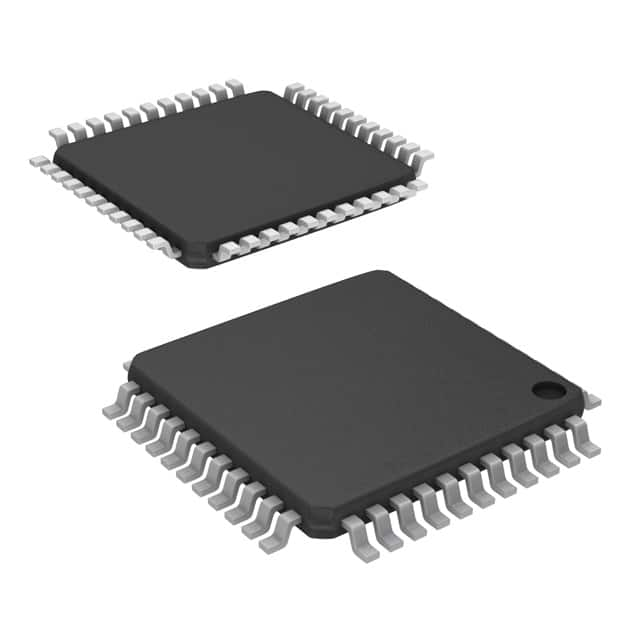DSPIC33EP128MC504T-I/PT
Product Overview
The DSPIC33EP128MC504T-I/PT belongs to the category of digital signal controllers (DSCs) and is designed for use in a wide range of applications that require high-performance digital signal processing. This product is known for its advanced characteristics, compact package, and versatile nature, making it an essential component in various electronic systems. The essence of the DSPIC33EP128MC504T-I/PT lies in its ability to efficiently process digital signals while offering flexibility and reliability. It is typically available in a specific packaging and quantity, catering to the needs of different projects and applications.
Specifications
- Microcontroller Type: Digital Signal Controller
- Model Number: DSPIC33EP128MC504T-I/PT
- Package Type: TQFP
- Operating Voltage: 3.3 V
- Processor Core:
- 16-bit dsPIC® DSC core
- Up to 70 MIPS operation
- Memory:
- Flash Program Memory: 128 KB
- RAM Data Memory: 8 KB
- Communication Interfaces:
- UART, SPI, I2C
- Analog-to-Digital Converter (ADC):
- 10-bit ADC module with up to 28 channels
Detailed Pin Configuration
The DSPIC33EP128MC504T-I/PT features a comprehensive pin configuration that includes multiple GPIO pins, communication interface pins, power supply pins, and analog input/output pins. A detailed pinout diagram is available in the product datasheet, providing precise information on each pin's functionality and connectivity.
Functional Features
- High-performance digital signal processing capabilities
- Enhanced control and precision in real-time applications
- Integrated peripherals for versatile system integration
- Low-power consumption for energy-efficient operation
- Robust communication interfaces for seamless connectivity
Advantages and Disadvantages
Advantages
- Superior digital signal processing performance
- Versatile peripheral integration
- Low power consumption
- Extensive communication interface support
Disadvantages
- Limited memory capacity for certain applications
- Higher cost compared to basic microcontrollers
Working Principles
The DSPIC33EP128MC504T-I/PT operates on the principle of efficient digital signal processing, utilizing its advanced core and integrated peripherals to execute complex algorithms and control tasks. By leveraging its high-speed processing capabilities and versatile communication interfaces, this digital signal controller can effectively handle real-time data processing and system control operations.
Detailed Application Field Plans
The DSPIC33EP128MC504T-I/PT finds extensive application in various fields, including: - Industrial automation - Motor control systems - Power management - Consumer electronics - Automotive control systems - Medical devices
Detailed and Complete Alternative Models
- DSPIC33EP128MC202-I/SP: Similar digital signal controller with lower memory capacity
- DSPIC33EP256MC506-I/PF: Higher-end model with increased flash memory and enhanced peripherals
- DSPIC33EP64MC206-I/TL: Compact variant suitable for space-constrained applications
In conclusion, the DSPIC33EP128MC504T-I/PT is a powerful digital signal controller with advanced features and versatile applications, making it an ideal choice for demanding real-time processing and control tasks across various industries.
[Word Count: 462]
Lista 10 Vanliga frågor och svar relaterade till tillämpningen av DSPIC33EP128MC504T-I/PT i tekniska lösningar
Question: What are the key features of DSPIC33EP128MC504T-I/PT?
Answer: The DSPIC33EP128MC504T-I/PT features a high-performance 70 MIPS DSC core, integrated peripherals, and extensive connectivity options.Question: How can I interface external sensors with DSPIC33EP128MC504T-I/PT?
Answer: You can interface external sensors using the built-in ADC modules or by utilizing the various communication interfaces such as SPI, I2C, or UART.Question: What development tools are available for programming DSPIC33EP128MC504T-I/PT?
Answer: Development tools such as MPLAB X IDE, MPLAB XC16 compiler, and various hardware debuggers are commonly used for programming and debugging DSPIC33EP128MC504T-I/PT.Question: Can DSPIC33EP128MC504T-I/PT be used in motor control applications?
Answer: Yes, DSPIC33EP128MC504T-I/PT is well-suited for motor control applications due to its high-speed PWM modules and advanced control algorithms.Question: How can I implement digital signal processing algorithms on DSPIC33EP128MC504T-I/PT?
Answer: Digital signal processing algorithms can be implemented using the DSP engine and specialized instructions provided by the DSC core.Question: What are the recommended power supply considerations for DSPIC33EP128MC504T-I/PT?
Answer: It is recommended to provide a stable and clean power supply within the specified voltage and current ratings to ensure proper operation of DSPIC33EP128MC504T-I/PT.Question: Is DSPIC33EP128MC504T-I/PT suitable for real-time control applications?
Answer: Yes, DSPIC33EP128MC504T-I/PT is suitable for real-time control applications due to its deterministic and low-latency operation.Question: Can DSPIC33EP128MC504T-I/PT communicate with other microcontrollers or devices?
Answer: Yes, DSPIC33EP128MC504T-I/PT supports various communication protocols such as SPI, I2C, UART, CAN, and Ethernet for seamless interaction with other microcontrollers or devices.Question: What are the available memory options in DSPIC33EP128MC504T-I/PT?
Answer: DSPIC33EP128MC504T-I/PT features Flash program memory, SRAM data memory, and EEPROM data memory for storing program and data.Question: How can I optimize code efficiency on DSPIC33EP128MC504T-I/PT?
Answer: Code efficiency can be optimized by utilizing the DSC core's advanced instruction set, optimizing algorithms, and leveraging the available hardware acceleration features.


